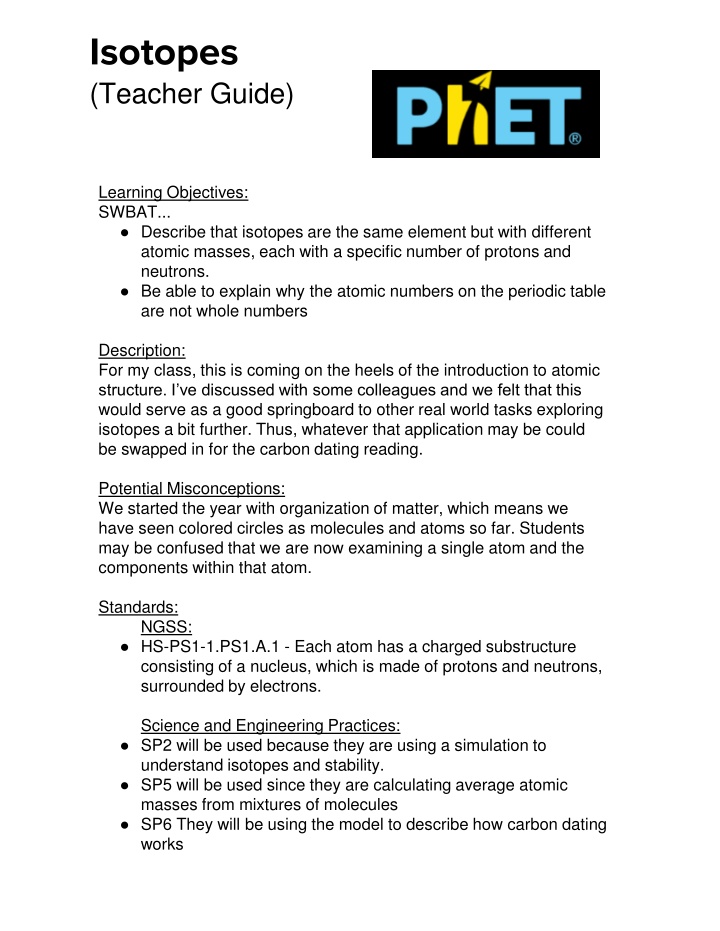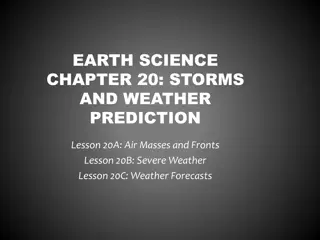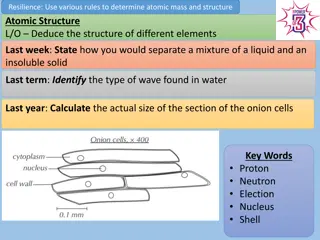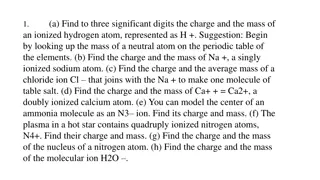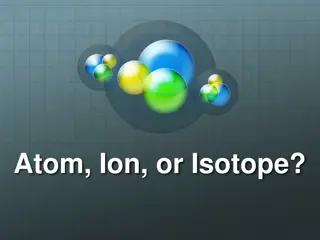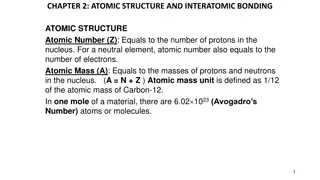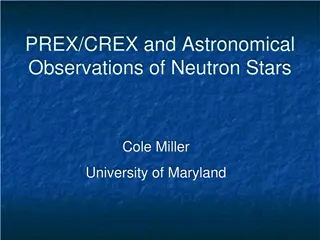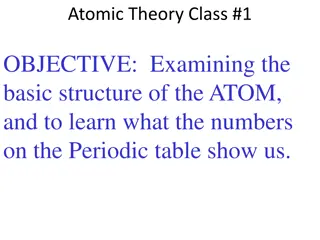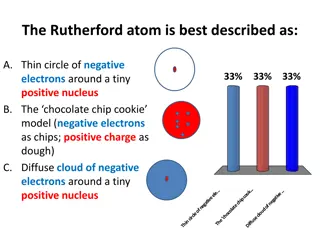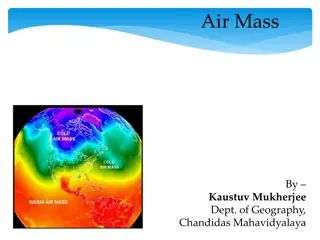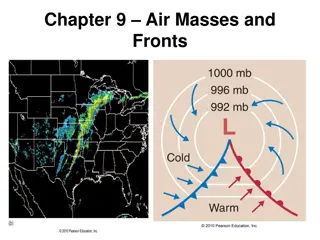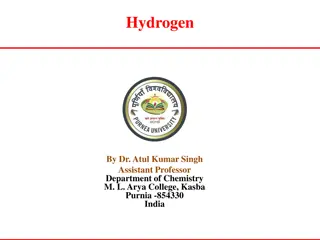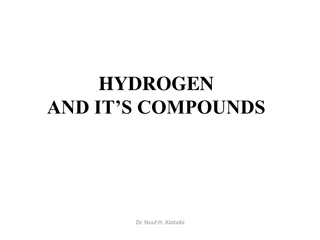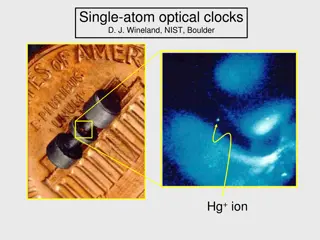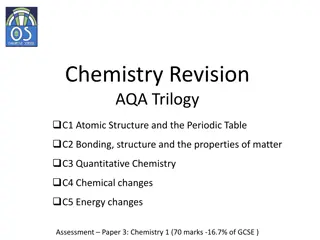Isotopes: Exploring Atomic Masses
In this teacher guide, students will learn about isotopes and their relation to atomic structure, stability, and carbon dating. Through hands-on exploration and theoretical development, misconceptions about atoms and molecules are addressed while meeting NGSS standards. The activities involve using simulations to understand natural isotope abundance, stability, and average atomic mass calculations. Engage in interactive tasks to grasp the concept of isotopes and their significance in scientific applications.
Download Presentation

Please find below an Image/Link to download the presentation.
The content on the website is provided AS IS for your information and personal use only. It may not be sold, licensed, or shared on other websites without obtaining consent from the author.If you encounter any issues during the download, it is possible that the publisher has removed the file from their server.
You are allowed to download the files provided on this website for personal or commercial use, subject to the condition that they are used lawfully. All files are the property of their respective owners.
The content on the website is provided AS IS for your information and personal use only. It may not be sold, licensed, or shared on other websites without obtaining consent from the author.
E N D
Presentation Transcript
Isotopes (Teacher Guide) Learning Objectives: SWBAT... Describe that isotopes are the same element but with different atomic masses, each with a specific number of protons and neutrons. Be able to explain why the atomic numbers on the periodic table are not whole numbers Description: For my class, this is coming on the heels of the introduction to atomic structure. I ve discussed with some colleagues and we felt that this would serve as a good springboard to other real world tasks exploring isotopes a bit further. Thus, whatever that application may be could be swapped in for the carbon dating reading. Potential Misconceptions: We started the year with organization of matter, which means we have seen colored circles as molecules and atoms so far. Students may be confused that we are now examining a single atom and the components within that atom. Standards: NGSS: HS-PS1-1.PS1.A.1 - Each atom has a charged substructure consisting of a nucleus, which is made of protons and neutrons, surrounded by electrons. Science and Engineering Practices: SP2 will be used because they are using a simulation to understand isotopes and stability. SP5 will be used since they are calculating average atomic masses from mixtures of molecules SP6 They will be using the model to describe how carbon dating works
Isotopes Name: Part A: Exploration Go to the isotopes section of the simulation. Once inside, play around with the various tools for a few minutes. Were you able to find . ...How to add and remove neutrons ...What adding neutrons does the the atomic symbol and molecular model ...Figure out what abundance in nature means ...Discover which is heavier, a proton or a neutron ...Explore some ideas about what makes an atom stable or unstable If not, try playing around a bit more until you find all of these items. Once you ve found them all, move on to Part B. Part B: Developing Theories Symbol Lithium-5 Lithium-7 Lithium-8 Name Number of Neutrons 4 Natural Abundance 0% Stable Stable?
Part B cont.: 1) What is the relationship between natural abundance and stability? 2) What is an isotope? Based on your interaction with the simulation, what do you think this is describing? (Hint: look what it says in the abundance in nature tab about isotopes) Dating a Fossil: As soon as a living organism dies, it stops taking in new carbon. The ratio of carbon- 12 to carbon-14 at the moment of death is the same as every other living thing, but the carbon-14 decays and is not replaced. The carbon-14 decays with its half-life of 5,700 years, while the amount of carbon- 12 remains constant in the sample. By looking at the ratio of carbon-12 to carbon- 14 in the sample and comparing it to the ratio in a living organism, it is possible to determine the age of a formerly living thing fairly precisely. 3) Why does the amount of C-14 go down? Justify your answer using the simulation. Marshall Brain "How Carbon-14 Dating Works" 3 October 2000. HowStuffWorks.com. <http://science.howstuffworks.com/environmental/earth/geology/carbon-14.htm> 25 September 2016
Part C: Mixtures Play around with the simulation making sure you can do the following ...Add two different isotopes to the box ...Use the slider tool to quickly add atoms to the box ...Change the percent composition at will ...Make the average atomic mass go up or down intentionally ...See nature s mix ...Find an element with more than 2 isotopes Part D: Average Atomic Mass Clear the box of all atoms. Then add the following combinations of atoms and fill out the table. * challenge problems Element Number of Isotopes Average Atomic Mass Hydrogen H-1: 10 H-2: 10 Hydrogen H-1: 10 H-2: 5 Hydrogen H-1: 10 H-2: 0 Oxygen O-16: 3 O-17: 3 O-18: 3 Oxygen O-16: 3 O-17: 0 O-18: 3 Oxygen O-16: 10 O-17: 5 O-18: 1 * 25.65 amu * 37.465 amu * 21.563 amu
Part D cont.: 4) Name two things that determine the average atomic mass of an element. 5) Look at the natural abundance for 3 different elements and find their average atomic masses. Element 1: Mass in Nature: Avg. Atomic Element 2: Mass in Nature: Avg. Atomic Element 3: Mass in Nature: Avg. Atomic 6) Compare the values you just got for the average atomic mass and look at the periodic table for those elements. What do you notice? 7) Describe what is the number on the bottom of each elemental symbol on the periodic table telling you? 8) Take a look at Boron (B) on the periodic table. Make a guess about which isotope of Boron is the most abundant. Justify your answer.
